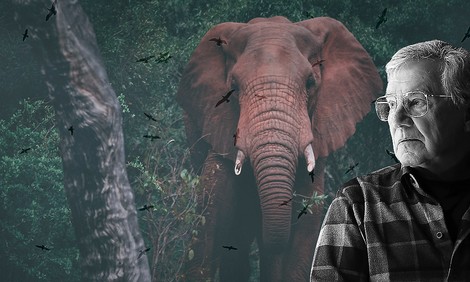sharing is caring
ist wirklich so!
Vielen Dank fürs Teilen!
Kluge Köpfe filtern für dich relevante Beiträge aus dem Netz.
Entdecke handverlesene Artikel, Videos und Audios zu deinen Themen.

Benedikt Sarreiter ist Mitglied des Redaktionsbüros Nansen & Piccard, schreibt für verschiedene Medien, ist Textchef des Schweizer du-Magazins und hat 2015 mit Paul-Philipp Hanske das Buch "Neues von der anderen Seite. Die Wiederentdeckung des Psychedelischen" bei Suhrkamp veröffentlicht. Er lebt in München.
Der Autor Tobias Fischer erzählt in diesem Text über die Errungenschaften des Toningenieurs und Musikers Bernie Krause auf dem Feld der Tierstimmen-Forschung. Krause nahm für sein Fieldrecording-Archiv 4500 Stunden Tierstimmen von 15.000 Spezies auf. Lange Zeit betrachtete er diese Stimmen als Einzelphänomene, die im Wettstreit mit den anderen standen. Bis er feststellte, dass jede Tierart sich auf einer eigenen Frequenz unterhält, die wiederum im Konzert der Laute einen eigenen, spezifischen Platz hat. Das hat Gründe:
Taking into account the importance of their calls for protecting their territory and attracting suitable mates, every lost emission was either a threat to their own life or the survival of their species. Which left only one possible conclusion for Krause: Animals had to find ways of cutting through this wall of sound and they did this by claiming their own frequency in the sonic spectrum. And so, the lower ends are usually taken by mammals, from the subsonic utterances of giraffes, elephants and hippos to the sounds of monkeys and cats. Further up in the spectrum, one finds different species of birds, which have arguably taken the art of song to an unprecedented degree of refinement. The highest frequencies, finally, are secured by insects and the ultra-sonics of bats.
Diese Aufteilung hat eine lange Geschichte:
What we’re hearing when we’re listening to animal sounds, therefore, is anything but the spur of the moment, but the product of millions of years of adaptation and transformation, of individual changes within a huge sound body filled to the brim with information, in which every part is related in intricate ways.
Auch der Mensch hat sich dieser Welt im Laufe seiner Geschichte angepasst, um besser jagen zu können oder sich vor Gefahren zu schützen. Mittlerweile haben wir diese Fähigkeiten fast verloren, wir fühlen sie nur noch. Fischer nennt dafür Beispiele im Text. Außerdem stören wir das Orchester der Tierstimmen mit unserem Handeln oft empfindlich. Fischer erzählt von Krauses Aufnahmen in einem Wald, der einen Holzeinschlag hatte. Krause nahm die Tiere vor dem Einsatz der Holzfäller auf und danach:
In keeping with what had been promised by the logging company, the place still looked as though it was teeming with life — “I was delighted to see that little seemed to have changed,” as Krause remarked. Back in the studio and after a look at his spectrogram, he had to revise that impression: “Gone was the thriving density and diversity of birds. Gone, too, was the overall richness that had been present the year before. The only prominent sounds were the stream and hammering of a Williamson’s sapsucker.” The ear, then, turned out to be capable of detecting the true state of the habitat much more precisely and truthfully than the eye ever could.
Interessant, nicht wahr? So wie der gesamte Text.

Quelle: Tobias Fischer EN thereader.mitpress.mit.edu
Einfach die Hörempfehlungen unserer Kurator'innen als Feed in deinem Podcatcher abonnieren. Fertig ist das Ohrenglück!


Öffne deinen Podcast Feed in AntennaPod:
Wenn alles geklappt hat,
kannst du das Fenster schließen.

Öffne deinen Podcast Feed in Apple Podcasts:
Wenn alles geklappt hat,
kannst du das Fenster schließen.

Öffne deinen Podcast Feed in Downcast:
Wenn alles geklappt hat,
kannst du das Fenster schließen.

Öffne deinen Podcast Feed in Instacast:
Wenn alles geklappt hat,
kannst du das Fenster schließen.

Öffne deinen Podcast Feed in Apple Podcasts:
Wenn alles geklappt hat,
kannst du das Fenster schließen.

Öffne deinen Podcast Feed in Podgrasp:
Wenn alles geklappt hat,
kannst du das Fenster schließen.

Bitte kopiere die URL und füge sie in deine
Podcast- oder RSS-APP ein.
Wenn du fertig bist,
kannst du das Fenster schließen.

Öffne deinen Podcast Feed in gpodder.net:
Wenn alles geklappt hat,
kannst du das Fenster schließen.

Öffne deinen Podcast Feed in Pocket Casts:
Wenn alles geklappt hat,
kannst du das Fenster schließen.
faszinierend. Diese sound-ökosphäre, diese jeweilige sound-Nische - interessantes recht neues Forschungsfeld. und wie man am Beispiel Holzfäller sieht auch ein guter Indikator für Zustand eines ökosystems (vorallem weil auch Pflanzen und Bäume einen Sound haben).